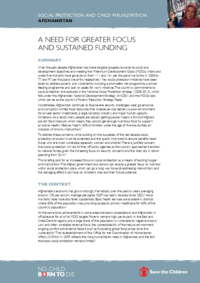
Briefs, Fact Sheets and Brochures
Social Protection and Child Malnutrition in Bangladesh: Impressive achievements – but stunting remains a challenge
Publication year:
2012
English
Format:
pdf (1.6 MiB)
Publisher:
Save the Children UK
Bangladesh has an impressive record in reducing poverty and child mortality. The number of people living below the poverty line went down by 40% in the ten years to 2010. And the rate of neonatal and infant mortality has shown a continuous decline, with Bangladesh on track to achieve Millennium Development Goal (MDG) 4 by 2015. In 1990, the MDG baseline year, the proportion of underweight children was 71%. According to the 2011 Demographic and Health Survey, underweight among children under five has gone down from 41% in 2007 to 36% in 2011, and breastfeeding has gone up from 46% to 64%. This is all good news and a great achievement.
However, although the percentage of children who are stunted has fallen from 68% in 1990, the same survey reveals the figure has dropped by just two percentage points over the past five years, from 43% to 41%. One in four families is food insecure, with 40% of people in rural areas unable to afford a minimum-cost nutritious diet. Long-term malnutrition remains an ongoing problem, affecting the development of millions of children.
Despite a number of social protection and safety net programmes, the country has lacked a coordinated national strategy on social protection, and few programmes are directed specifically at children. The current Health, Population and Nutrition Sector Programme should prioritise reducing stunting. This briefing provides a number of guidelines on how social protection programmes can improve children’s nutrition.
Read full abstract
Authors
View & Download
Document information
Publisher
Authors
Format
Content type
Country
Region
Rights
© Author/Publisher
Found a mistake? Help us improve!
If you have noticed a document assigned to the wrong author or any other inaccuracies, let us know! Your feedback helps us keep our data accurate and useful for everyone.
Share
Link

